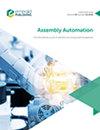面向医疗人机交互的人类活动感知共享控制解决方案
IF 1.7
4区 计算机科学
Q3 AUTOMATION & CONTROL SYSTEMS
引用次数: 39
摘要
目的本文旨在为外科手术中的人机交互开发一种具有人类活动意识的自适应共享控制解决方案。手控和遥操作是遥操作微创外科手术中经常切换的两种主要手术方式。可以使用传感器信息来定义和识别程序中的详细人类活动。本文针对手术场景中具有笛卡尔阻抗控制的机械手,提出了一种新的连续自适应共享控制方法。设计/方法论/方法引入了一种通过调整权重函数来实现不同人类活动之间的平稳过渡的人类活动感知共享控制解决方案,包括动手控制和远程操作。所提出的解决方案没有在手术过程中引入各种控制器并在它们之间切换,而是将所有基于人类活动的控制器集成到一个控制器中,并且程序之间的转换是平稳和稳定的。在实验室设置环境中验证了所提出的控制方法的有效性。结果表明,机器人的行为稳定、平稳。该算法是可行的,可以实现手术中人机交互的人类活动感知自适应共享控制解决方案。发现基于实验,结果证实了所提出的人类活动感知自适应共享控制解决方案可以利用实时传感器信息自动切换设备行为。不同活动之间的过渡是平稳的。实际意义对于远程手术应用,所提出的方法通过使用实时传感器信息识别活动,将各种人类活动的不同控制器集成到一个控制器中,并且不同程序之间的转换平稳。它简化了外科医生的手术工作,并提高了控制模式转换期间的安全性。所提出的方案提供了一个通用的解决方案来解决远程操作MIS.Originality/value中的工作程序切换问题。据作者所知,本文首次提出了用于外科手术中人机交互的人类活动感知自适应共享控制解决方案。本文章由计算机程序翻译,如有差异,请以英文原文为准。
A human activity-aware shared control solution for medical human–robot interaction
Purpose
The purpose of this paper is to develop a human activity-aware adaptive shared control solution for human–robot interaction in surgical operation. Hands-on control and teleoperation are two main procedures switched frequently in teleoperated minimally invasive surgery (MIS). The detailed human activity in the procedures can be defined and recognized using the sensor information. In this paper, a novel continuous adaptive shared control method is proposed for manipulators with Cartesian impedance control in the surgical scenario.
Design/methodology/approach
A human activity-aware shared control solution by adjusting the weight function is introduced to achieve smooth transition among different human activities, including hands-on control and teleoperation. Instead of introducing various controllers and switching among them during the surgical procedures, the proposed solution integrated all the human activity-based controllers into a single controller and the transition among the procedures is smooth and stable. The effectiveness of the proposed control approach was verified in a lab setup environment. The results prove that the robot behavior is stable and smooth. The algorithm is feasible and can achieve a human activity-aware adaptive shared control solution for human–robot interaction in surgical operation.
Findings
Based on the experiment, the results confirm that the proposed human activity-aware adaptive shared control solution can switch the device behavior automatically using the real-time sensor information. The transition between different activities is smooth and stable.
Practical implications
For teleoperated surgical applications, the proposed method integrated different controllers for various human activities into a single controller by recognizing the activities using the real-time sensor information and the transition between different procedures is smooth and stable. It eases the surgical work for the surgeon and enhances the safety during the transition of control modes. The presented scheme provides a general solution to address the switching of working procedures in teleoperated MIS.
Originality/value
To the best of the authors’ knowledge, this paper is the first to propose human activity-aware adaptive shared control solution for human–robot interaction in surgical operations.
求助全文
通过发布文献求助,成功后即可免费获取论文全文。
去求助
来源期刊

Assembly Automation
工程技术-工程:制造
CiteScore
4.30
自引率
14.30%
发文量
51
审稿时长
3.3 months
期刊介绍:
Assembly Automation publishes peer reviewed research articles, technology reviews and specially commissioned case studies. Each issue includes high quality content covering all aspects of assembly technology and automation, and reflecting the most interesting and strategically important research and development activities from around the world. Because of this, readers can stay at the very forefront of industry developments.
All research articles undergo rigorous double-blind peer review, and the journal’s policy of not publishing work that has only been tested in simulation means that only the very best and most practical research articles are included. This ensures that the material that is published has real relevance and value for commercial manufacturing and research organizations.
 求助内容:
求助内容: 应助结果提醒方式:
应助结果提醒方式:


